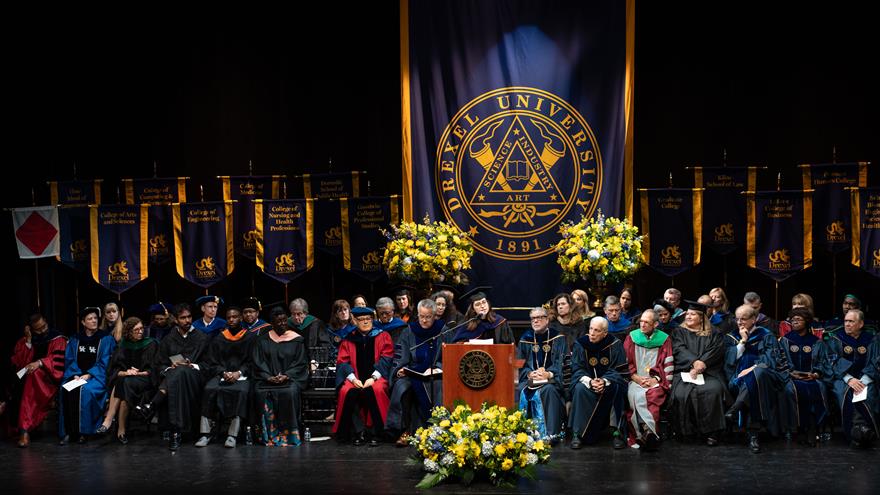Q&A With Kevin Woodson: 50 Years After the March on Washington

- Convocation 2023: Personal Stories of Impact “Only Possible at Drexel”
- Drexel Awarded $850K Grant from The Pew Charitable Trusts To Help Make Atwater Kent Collection Accessible to Public
- ‘Seeing Philadelphia,’ a Selection From the Atwater Kent Collection at Drexel University Goes on Display
- Justice of the Supreme Court of New Jersey to Keynote Kline Law Commencement

The March on Washington for Jobs and Freedom became a key moment in the struggle for equality in the United States, and today is being commemorated across the nation. But despite the gains of the civil rights era, racial inequality undoubtedly still exists.
Kevin Woodson, PhD, an assistant professor in the Earle Mack School of Law at Drexel University, focuses his studies on socioeconomic and racial inequality issues. Currently, Woodson is working on a paper that addresses wealth inequality in America and the manner in which the education system reproduces this disparity, generation after generation.
Woodson said he thinks it’s important for the nation to recognize and celebrate the hard-earned victories of the past without losing sight of the formidable problems that remain.
Why do we as a nation commemorate the March on Washington for Jobs and Freedom?
First, it was an extraordinary, unprecedented feat of political activism. The March is in some respects, the “crossover” moment of the civil rights movement. It was no longer just a “black thing” or even a “Southern thing,” it was an American thing, a national movement, the likes of which had never been seen before.
It also marked the beginning of the zenith of the civil rights movement in America. It was followed in short order by the landmark Civil Rights Act of 1964 and the Voting Rights Act of 1965. The march and those subsequent legislative achievements represent one of the greatest “feel-good stories” of American history. It represents a high point in civic idealism and demonstrates the potential power of even the most disadvantaged citizens engaging in the political process through direct participation.
For these reasons, the march serves as an inspiration for activists and advocates today. Some hold out hope to this day that mass, organized marches can be used to bring racial injustices to the public’s attention and motivate the government to address them.
John F. Kennedy, the president at the time, worried that the march would alienate Congressmen who might otherwise support civil rights legislation. Do you think that same skepticism exists today during civil rights gatherings?
This march threatened to put Kennedy in a lose-lose position politically. He could embrace the march and alienate many white Democrats and Southerners, or he could refrain from supporting it and risk alienating black Americans and the liberal wing of the party.
It is also worth noting that the threat of violence loomed very large. White supremacists had recently murdered NAACP leader Medgar Evers in Mississippi. Black youth were becoming increasingly militant and fed up with the slow pace of racial progress. Kennedy and others felt that violence or disorder from white racists or black militants could fatally undermine any future attempts to pass civil rights legislation.
I don’t think that we have the same skepticism today—we have different sources of skepticism. Many feel that mass marches like these are outdated and no longer useful in influencing government. Others are now less sympathetic to the goals of racial justice.
How have we grown as a nation after 50 years?
America has made substantial progress. Racial gaps in income and education have narrowed. The group of high-income black corporate professionals who I write about in my research did not exist 50 years ago. A black man was elected governor of Virginia, the former heart of the Confederacy, and black men have served in Congress. A black man has been elected and reelected to the White House.
On a more personal note, my father, and many other black Americans who lived in the South, attended racially segregated schools 50 years ago, even after the Supreme Court forbid such practices in Brown v. Board, a decade earlier, in 1954. By contrast, I have attended racially integrated schools my entire life and attended college, law school and graduate school at universities that had very little racial minority presence 50 years ago.
The march was part of a movement to fight poverty and provide opportunity. Today, our nation still struggles with racial disparities. What do you think are our biggest issues today?
Despite progress in closing the income gap, the black-white wealth gap remains staggeringly high, and is passed down from one generation to the next.
Because of a number of problems, black Americans often have less access to “good jobs.” Racial discrimination still remains, especially in entry-level jobs where study after study has found that employers prefer to hire non-black workers. Many black people lack the social networks and personal contacts that many white Americans use to find employment. Because disparate numbers of black Americans are born into poor families in disadvantaged neighborhoods, black children disproportionately are forced to attend the worst-performing schools in the country, schools that are unable to ensure that they are ready for the workforce. Finally, our nation’s mass incarceration approach to drug crimes, and its targeting of poor minority communities for enforcement of these laws, has stamped many young black men as ex-felons, subjecting them to even more discrimination from potential employers and rendering many of them unemployable in some of their prime work years.
What can we do to combat our issues?
Combating these issues will require considerable political will, economic resources and sympathy toward poor black communities. Massive educational reform, job training and public works projects, criminal justice reforms and alternative approaches to treating drug addiction and abuse would be a great start.
In This Article
Drexel News is produced by
University Marketing and Communications.